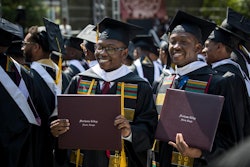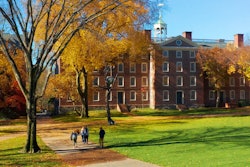Drawing Upon the Diaspora
Immigrant-Origin Blacks Gaining Presence at Elite Institutions
By Ronald Roach
Callie Watkins entered Harvard University looking forward to interacting with a diverse student population. The freshman was one of more than
120 Black students to enter Harvard in 2001, most of whom, she figured, would be U.S.-born. Instead what she found proved to be the exact opposite — most of the Black students were either immigrants, children of immigrants, or hailed directly from foreign countries. U.S.-born Blacks from non-immigrant families constituted a distinct minority, even within the Black population.
“I expected there would be many more Blacks from families that had a long history in America going back to slavery. There must have been about 30 or so in that category,” says Watkins, who has roots in the Cape Verde islands on her mother’s side and the United States on her father’s side. “I was in a middle category, and I floated between the different groups of Black students.”
So it didn’t come as a surprise to Watkins when Harvard professors Dr. Henry Louis Gates Jr. and Lani Guinier pointed out during a Black alumni gathering in 2003 that the children of African and Caribbean immigrants and children of biracial couples together comprised two-thirds of Harvard’s Black undergraduate population. Of the university’s 530 Black undergraduates during the 2003-2004 academic year, only about 180 could claim a completely Black American heritage. Those remarks, bringing to light a little-discussed issue in affirmative action, surfaced last year in the national news media.
Writing in the Boston Globe in July 2004, Guinier contended that “many colleges rely on private networks that disproportionately benefit the children of African and West Indian immigrants who come from majority Black countries and who arrived in the United States after 1965. … Like their wealthier White counterparts, many first- and second-generation immigrants of color test well because they retain a national identity free of America’s racial caste system and enjoy material and cultural advantages, including professional or well-educated parents.”
It’s not surprising that Guinier’s and Gates’ comments put highly competitive American colleges and universities in an awkward position since most of them have cautiously practiced affirmative action since the U.S. Supreme Court’s 2003 Grutter v. Bollinger decision validated the use of race and ethnicity in academic admissions. Far from responding or clarifying their commitment to affirmative action, schools have plowed ahead without saying much of anything about affirmative action as it relates to Black student diversity.
“This is a victory of diversity over justice. The traditional mission of affirmative action seems to be eclipsed,” says Dr. Philip Kasinitz, a sociologist at the City University of New York Graduate Center and Hunter College, who has studied immigrant communities extensively in the New York metropolitan area.
Scholars who have examined the Black presence in elite colleges and universities have reported that 41 percent of Black freshmen at 28 selective schools identified themselves as immigrants, children of
immigrants or mixed race. While schools have not yet clarified their position on affirmative action with regard to native Black American students, a number of scholars and activists have found the issue a timely one upon which to boost their research and advocacy agendas.
Princeton sociologist Dr. Douglas Massey was one of the co-authors of The Source of the River: The Social Origins of Freshmen at America’s Selective Colleges and Universities, which published the research on Black student origins at the 28 selective schools. The furor over Black student representation has since drawn him and his colleagues into interpreting and commenting on the research data for the public and the news media.
“This wasn’t a priority from the beginning,” Massey says, noting that The Source of the River, published in 2002, was written to examine the “roots of minority underperformance in selective colleges and universities.”
The Harvard controversy, however, has prompted Massey and two colleagues to write “Black Immigrants and Black Natives Attending Selective Colleges and Universities in the United States,” a paper which makes the point that affirmative action’s “new emphasis on diversity also benefited Blacks of immigrant origin and similarly led to a sharp increase in their representation among African-Americans at elite institutions.”
“I was surprised to the extent [immigrant-origin students] were over-represented,” Massey says, who notes in the article that Black immigrant families comprise 3 percent of the African-American population.
STIRRING THE RESEARCH POT
The Harvard controversy has put the spotlight on research that has examined African and Caribbean immigrant-origin students and their families. In particular, it has helped illuminate the work of sociologists who have studied Black immigrant families in the New York City metropolitan area and in south Florida.
In surveys of students from West Indian families conducted by Harvard sociologist Dr. Mary C. Waters, City University of New York sociologist Dr. John H. Mollenkopf and Kasinitz, Mollenkopf notes that while education is highly valued in those communities, the majority of students are not going to elite colleges.
“West Indians are pretty well-educated. They have a middle-class perspective,” he says, adding that the English-proficient West Indian immigrants have achieved greater socioeconomic success than their Spanish-speaking Caribbean counterparts, such as Puerto Ricans and Dominicans, in the New York region.
In comparison to native Black Americans in the New York region, West Indians show higher levels of educational attainment among young adults, according to Mollenkopf. The inclusion of educational attainment and aspirations in their studies are measures that correlate to other indices of social and economic achievement, Mollenkopf says.
“The selection issue [as to who migrates from their home countries] is certainly part of the West Indian experience,” Mollenkopf says. “African-Americans are all over the [socioeconomic] spectrum. West Indians as immigrants cluster in neighborhoods outside traditional [native] Black communities.”
Other scholars regard the information being gathered on immigrant-origin Blacks as potentially beneficial to the research being done to help
close the academic achievement gap among racial groups in the United States. Some experts say the Harvard controversy has helped elevate the Black immigrant research.
“It’s really been an important issue. Present databases don’t allow us to disaggregate and distinguish African-Americans [whose ancestry is based] in the mainland U.S. from people who [are recent African and Caribbean immigrant origin],” says Dr. Michael T. Nettles, vice president for policy evaluation and research at the Educational Testing Service. “We need to be able to distinguish these people.”
Nettles says it will be valuable to know the national heritage of students who perform well at all levels of the academic spectrum, especially if “we monitor the progress of African-American enrollment in selective colleges.”
He adds that it is important to understand Black student origins because the large presence of immigrant-origin students may paint a different picture of African-American high achievement than what researchers, scholars and the public have assumed in the past.
“If Blacks are typically 5 and 6 percent of the population at elite colleges, then the representation of native U.S. born African-Americans might be closer to 3 percent,” Nettles says.
“It’s important to know because it may mean that researchers may have to alter the way they collect data on African-Americans,” Nettles says.
Some researchers, including CUNY’s Kasinitz, have suggested that data about African-Americans may have to be broken down into categories similar to those found in studies of Hispanics.
“Hispanics are studied by categories that are much more reflective of their heritage. Maybe, we need to do that with categories of people of African descent,” Nettles says. “When we ask them about parent’s socioeconomic status, we should take into account the country of origin as well.”
“In some ways, the African-American issue pales in comparison to the Latino issue,” Kasinitz says.
He adds that the Puerto Rican population at the City University of New York system has fallen while overall Latino numbers have risen. “We have to be more specific about what affirmative action is supposed to accomplish. There’s been a reluctance to do this,” Kasinitz says.
LEARNING FROM A COMPETITIVE COHORT
Futurist Nat Irvin II, an assistant dean at the Babcock Graduate School of Management at Wake Forest University, says the prevalence of immigrant-origin Black students at elite American colleges and universities may signal a natural development in the emergence of “thrivals,” a group he describes as internationally-oriented, well-educated and competitive Black people striving for global economic and cultural achievement, and seeking leadership positions throughout the world. U.S. Sen. Barack Obama, D-Ill., and U.N. Secretary General Kofi Annan represent influential members of the thrival class in the United States, he notes.
While they include native-born African-Americans as well as people of recent African and Caribbean descent, Irvin likens thrivals to the “overseas Chinese” and “overseas Indian” populations, which are described in business and economic literature as successful entrepreneurs in the nations in which they live. Thrivals have the potential of achieving economic success as the overseas Chinese and Indian groups have, as well as cultural and political success, he believes.
“This is a very powerful identity. I think it’s pretty widespread,” says Irvin, who has also founded Future Focus 2020, a think tank charged with engaging urban communities in futurist thinking. He notes that the thrival concept has taken root strongly among African and Caribbean immigrants to Europe and the Americas.
Irvin writes in “The Arrival of the Thrivals,” a 2004 article in The Futurist magazine, that as “thrivals establish and strengthen their economic base and watch it grow by leaps and bounds, they continue to be aware of the importance of education and its place in the transition from mere survival to true thrivalism.”
Instead of it pitting immigrant origin against native Black students, the Harvard controversy should spur native African-Americans into having a national conversation about educational and economic competitiveness, Irvin says. He says American born Blacks should be asking why the immigrant-origin students are doing well and seek to emulate their
example.
Along the same lines as Irvin, Dr. Edmund T. Gordon, the founder and director of Columbia University’s Institute for Urban and Minority Education, would like to see the Harvard controversy serve as a wake-up call to native African-Americans on the role education plays in facilitating socioeconomic mobility. The co-author with Dr. Beatrice Bridglall of the forthcoming book, Affirmative Development of Academic Ability, Gordon says that regardless of economic class, native Black Americans are by and large underperforming at the K-12 level and in colleges and universities. He advocates that parents provide supplementary education to boost their children’s education and performance.
“I think the African-American middle class is not doing what [it] should to enhance [its] children’s intellectual development,” Gordon says.
WHAT TO DO
Though Gates and Guinier have said they meant for their comments to bring attention to how the presence of native-born African-Americans in elite academic settings can be increased, some scholars believe the discussion has taken on too much of a tone that questions the right of Black immigrant-origin and biracial students to have high representation at certain schools. Dr. Kerry Ann Rockquemore, a sociologist at the University of Illinois-Chicago, finds the news media and Internet-based discussions to be divisive, especially as it relates to biracial students.
Rockquemore, who was born and raised by a White mother and a Black father, has studied biracial students extensively in her work as a sociologist. Though she considers it useful that the Harvard controversy has brought to light the fact that biracial students have higher representation at elite schools than their percentage in the Black population, Rockquemore says they are singled out as if they are completely distinct from native-born African-Americans.
“It’s clear to me why immigrant-origin Blacks represent a distinct sub-group of Blacks within the U.S. based on their unique cultural and social experiences, but it’s less clear to me what the difference between native African-Americans and [American-born] biracial students are,” she says.
Rockquemore explains that given the diversity of circumstances from which American-born biracial students come from, it’s problematic that people try to separate them from the African-American community when there’s been so little research about the social identity of biracial individuals.
“What makes the biracial child of a single Black mother different than the child whose father is Black but is raised by a single Black mother? What is the criteria that makes one person more Black than someone else?” Rockquemore asks. “The Black experience is very broad and the biracial experience is part of that broad experience.”
It has been pointed out that Guinier was born to a White mother and a Jamaican immigrant father. For her part, Guinier has weaved into her critique of elite schools the argument that such institutions do little or nothing to provide opportunities for the most socially disadvantaged of Americans, regardless of race. While she has argued that more aggressive recruiting is needed to attract overlooked native-born and economically-disadvantaged Blacks, she has also urged the same be done for the recruitment of poor Whites into elite institutions.
University of Chicago professor Dr. Kenneth Warren says elite schools can do a lot more to stimulate the college aspirations of minority and disadvantaged students in their local communities. Warren has headed an academic committee charged with improving the school’s minority outreach efforts.
“Part of what my colleagues and I have tried to do is to convince the university that academic programs that benefit students in the Chicago public schools don’t have to recruit every student we help into the University of Chicago,” Warren says. The goal should be to help students develop their college aspirations and their competitiveness.”
© Copyright 2005 by DiverseEducation.com


















